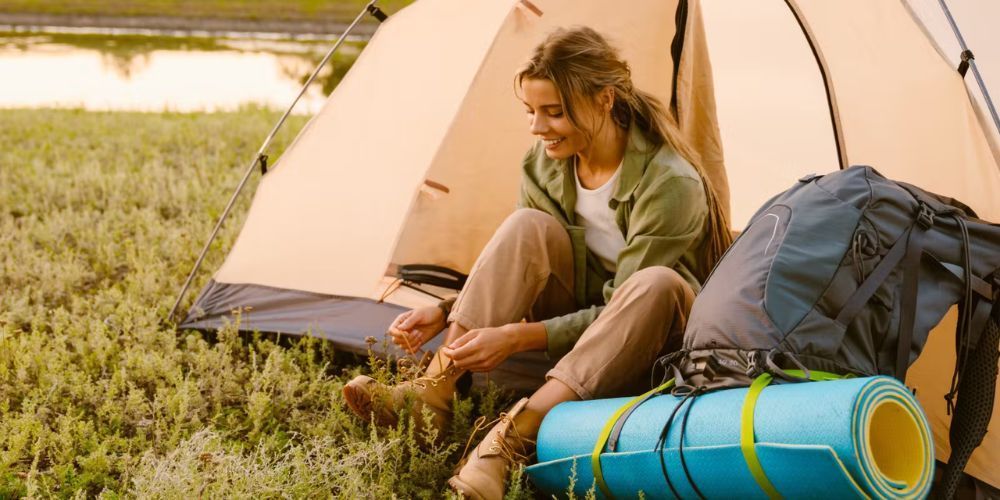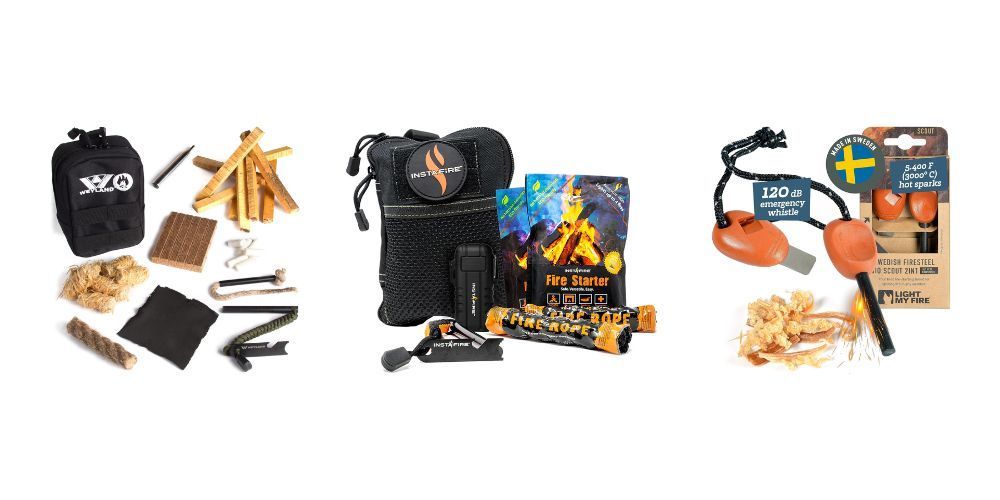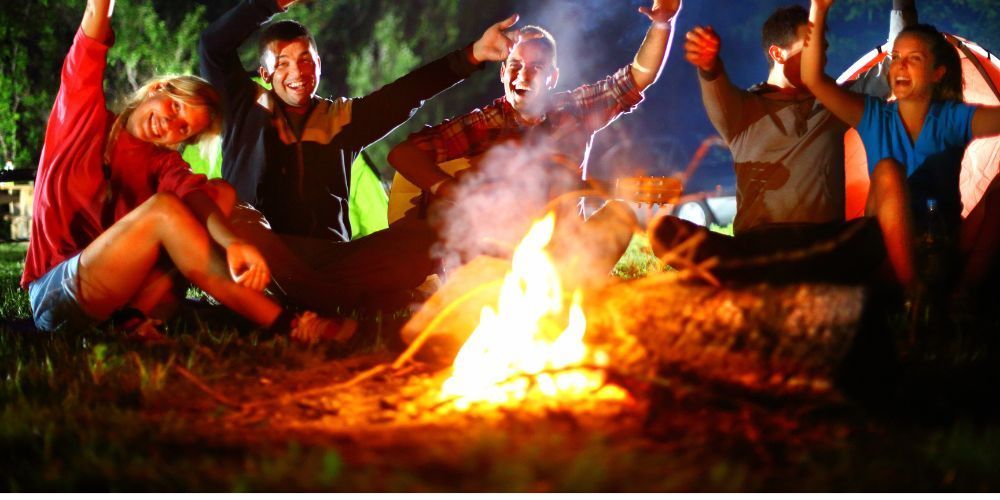Trail Safety Tips: How to Stay Safe While Hiking in the Wilderness
July 28, 2024
Hiking solo through a forest trail can be both exhilarating and nerve-wracking. The thrill of adventure often mingles with the anxiety of potential hazards, such as losing your way or encountering unpredictable wildlife. Understanding the real risks helps to ease these fears, especially when you know you're well-prepared.
By gathering insights from seasoned hikers who have navigated the most remote paths and experts who ensure outdoor safety, we've compiled vital tips that will arm you for any situation. What may surprise you is how thorough preparation can also make your hikes more enjoyable—leading to richer experiences and breathtaking photos in places you'd otherwise miss. Before setting out on your next hike, careful planning forms the bedrock of any safe wilderness trek.
When hiking alone, it's important to inform a responsible person of your plans, stay on designated trails, carry enough water, wear sturdy shoes, and be aware of wildlife encounters. Additionally, utilizing safety-enhancing apps like what3words and OuterSpatial can provide an extra layer of security during solo hikes.
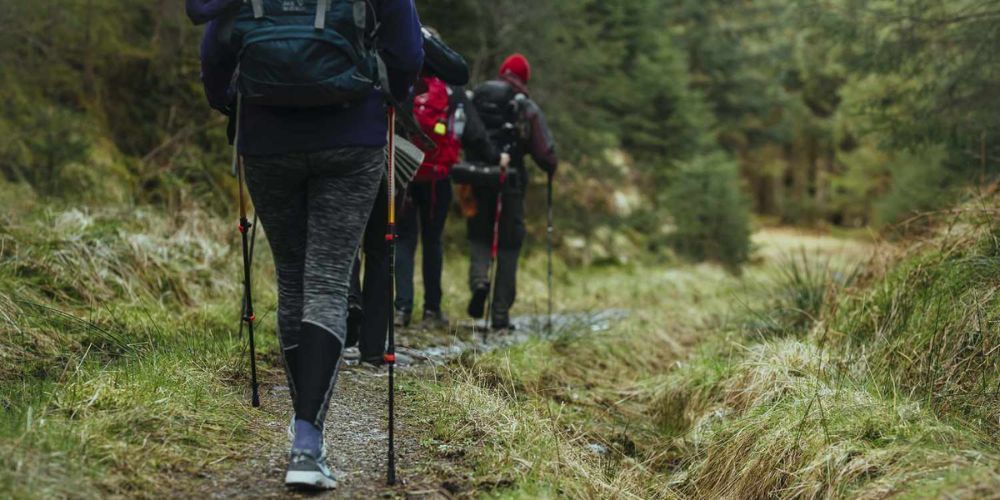
Planning Your Hike
Imagine this: you've picked a trail, the weather looks great, and you cannot wait to start your adventure. But before you lace up your boots, it's crucial to spend some time planning to ensure a smooth and safe hike. Let's dive into the steps you should take before setting foot on the trail.
Step I - Research Your Trail Thoroughly
Researching your trail is like looking at a map before going on an important journey—it's absolutely necessary. Websites like AllTrails are your best friends here. They provide valuable information such as trail length, difficulty level, and recent user reviews. These user reviews often mention specific hazards or features that might not be immediately obvious from official sources. By understanding these details, you'll know what to expect, which will help you adequately prepare for your hike.
It's like having a sneak peek of what's ahead before you actually get there!
Step II - Inform Others of Your Plans
Once you've done your research and formulated your hiking plans, it's vital to let someone responsible know about them. This includes sharing your route, expected return time, and any contingency plans in case something unexpected happens. This simple step is crucial in case of emergencies—imagine being stuck or injured with no one knowing where you are!
Sharing your plans with someone you trust ensures that if something does go wrong, help can be sent to find you.
Step III - Check Permits and Regulations
Imagine arriving at the trailhead just to find out you need a permit or that there are specific regulations you weren't aware of. It would surely put a damper on the day! To avoid this, always check the official park or trail website to ensure you're compliant with local rules. Some trails require permits due to limited access or environmental protection efforts, and not knowing about them in advance can lead to disappointment.
By taking the time to thoroughly research your chosen trail, inform others of your plans, and double-check for permits and regulations, you're setting yourself up for a safe and enjoyable wilderness experience. Remember, preparation is key!
As the saying goes, proper prior planning prevents poor performance. Now, let's move on to preparing our essential trail pack—a crucial element for ensuring a peaceful and secure hike experience.
Preparing a Trail Pack
When setting out on a hiking trip, your trail pack is essential for wilderness survival. You'll want to ensure you have everything you need in case of an emergency or unexpected situation. Your trail pack isn't just about carrying essential items; it's about being self-sufficient on the trails.
Hydration and Nutrition
Staying hydrated is crucial, with a rule of thumb being at least one quart (about one liter) every two hours of hiking. Also, packing energy-dense snacks like nuts, trail mix, and granola bars can keep your energy levels up, providing the fuel needed to keep going, especially on longer hikes when hunger can unexpectedly strike.
First Aid and Survival Gear
Accidents can still happen despite meticulous planning. Carrying a first-aid kit with essentials like bandages, antiseptics, and blister treatments is crucial. Additionally, a multi-tool is versatile for various tasks, and an emergency blanket can be a lifesaver in unexpected weather conditions or emergency situations.
Clothing and Footwear
Proper clothing and footwear are vital for comfort and safety during your hike. Dressing in layers allows you to adjust to changing weather conditions, while sturdy, comfortable hiking boots with good traction prevent injuries and ensure stability on uneven terrain.
Your trail pack is your lifeline in the wilderness—it provides peace of mind and prepares you for whatever the great outdoors may throw at you by ensuring that you're equipped with the right essentials for hydration, first aid, survival, and proper clothing.
Equipped with these fundamental packing strategies, you're better prepared to tackle the challenges of the wild. Now, let's turn our attention to reading the terrain and weather to further enhance your outdoor experience.
Reading the Terrain and Weather
When you're out on a hike, you're not just walking on a regular sidewalk. The landscape can be surprising and full of different features and challenges. Some trails have steep hills or rocky paths, while others might lead you through wetlands or thick forests. Knowing what to expect from the terrain before you start hiking allows you to be better prepared for any obstacles along the way. Similarly, keeping a keen eye on the weather can help ensure a safer and more enjoyable hike.
One way to prepare for the terrain is by using topographic maps. These maps are like blueprints of the land and provide detailed information about elevation changes, natural landmarks, and trail difficulty. Learning how to read these maps will help you anticipate challenging areas and plan alternate routes in case of unexpected obstacles.
Topographic maps are invaluable for navigating through unpredictable pathways, especially in unfamiliar or remote areas.
Moreover, it's crucial to keep an eye on weather patterns before and during your hike. While checking the weather forecast before setting off is important, it's equally essential to stay updated throughout your hike using apps like Weather Underground which provide real-time weather updates.
Storms, extreme heat, or high winds can pose serious risks to hikers. Monitoring the weather can help you avoid dangerous conditions, allowing you to make informed decisions about whether to continue your hike or seek shelter if necessary.
Real-time weather updates are crucial for avoiding dangerous conditions like thunderstorms and extreme heat.
By understanding the terrains through topographic maps and staying apprised of weather conditions using reliable resources, hikers can better plan their route and mitigate potential hazards along the trail.
Understanding the lay of the land and keeping a vigilant eye on the sky lays a sturdy foundation for safe hiking practices. Now, let's shift our focus towards enhancing safety through camaraderie in the wilderness—a practice that adds an extra layer of security and enjoyment to your outdoor adventure.
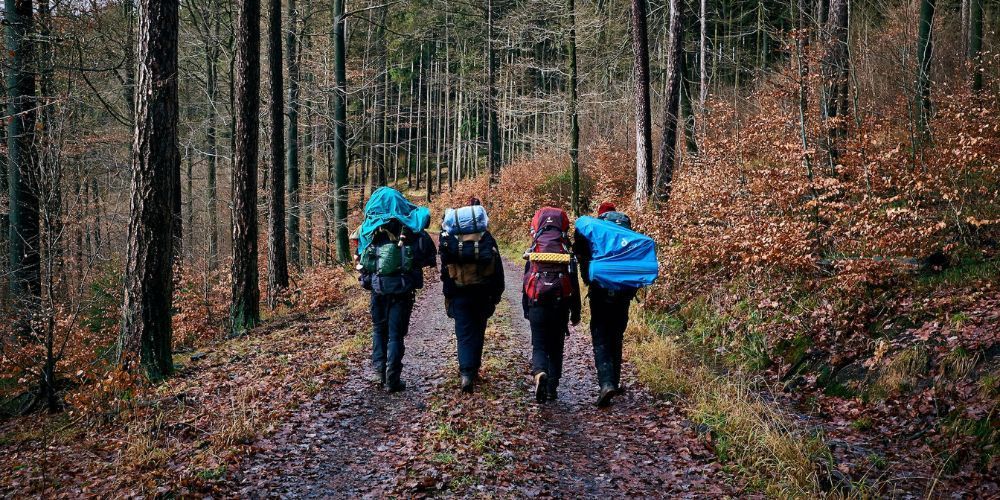
Hiking with Companions
When you're out in the wilderness, having friends or family members with you can make a big difference, especially when it comes to staying safe. Hiking with others not only offers a layer of protection against wildlife encounters but also provides crucial support in case of an emergency. The saying "safety in numbers" couldn't be more accurate.
Consider this: When you're hiking alone, there's no one else around to help you if you get hurt. But when you're with others, they can aid in first aid, help in decision-making, and provide emotional support. Moreover, the social aspect adds a layer of enjoyment to the experience - sharing stories and laughter as you hike along can make it all the more memorable.
Establishing Strong Communication Protocols
Communication is key. Just like setting up a tent or packing food, establish a basic protocol for keeping in touch while hiking together. This could include hand signals to communicate non-verbally or specific whistle blows to relay messages across longer distances. It's important that everyone is aware of the plan and knows what to do if anyone gets separated from the group.
Imagine this: You're on a trail and you need to quickly alert your group about a nearby hazard or an animal sighting without making too much noise. With established communication signals, you can discreetly convey important information without causing a disturbance.
Distributing Responsibilities
Sharing responsibilities within the group can streamline the hiking experience. Assigning roles such as navigator, pace-setter (someone who sets the pace for the group), and first-aid responder ensures that everyone has a part to play in keeping the hike safe and enjoyable for all.
Consider how this works: Each person has a defined task that contributes to the overall safety and enjoyment of the hike. For instance, the navigator is responsible for reading maps and ensuring the right path is followed, while the pace-setter maintains a comfortable walking speed to keep everyone together without overexerting anyone.
Think about the relief it brings: When everyone knows what they're supposed to do and trusts each other to take care of their designated responsibilities, it creates an environment where teamwork reduces stress and enhances safety.
So, by hiking with companions, you not only enhance your safety but also add depth to your outdoor experience through teamwork and shared responsibility.
In this exhilarating exploration of safety measures while exploring the great outdoors with companions, we've unearthed invaluable insights on fortifying the hiking experience. Now, let's venture into essential wilderness safety tips designed to bolster your confidence when braving nature alone.
Essential Wilderness Safety Tips
When hiking alone in the wild, it's crucial to understand how to keep yourself safe while enjoying the great outdoors. Here are some essential safety tips for your next solo adventure in the wilderness.
Navigation Tools
One of the most important things you can do to stay safe while hiking in the wilderness is to always carry a map and compass, even if you have a GPS device. Technology can fail, especially when you're off the grid, and traditional navigation tools serve as reliable backups.
You might be thinking, "But I have my smartphone with GPS, why bother with a map and compass?" While technology has advanced significantly, it's never completely infallible. Batteries run out, signals get lost, and devices break. A map and compass don't rely on batteries or signals—their usefulness will never run dry. Knowing how to use them effectively could mean the difference between finding your way back and being lost in the wild.
Wildlife Awareness
It's essential to learn about the wildlife in the area where you'll be hiking and how to respond to encounters. For instance, knowing how to react to a bear encounter can make a significant difference in your safety. Don't run; instead, make yourself look bigger by raising your arms and slowly backing away. This action can help prevent potential harm from a surprise encounter with wildlife.
Understanding wildlife behavior and knowing how to react can be a lifesaving skill when hiking in the wilderness. Animals have their own territories and behaviors, and knowing how to respect these boundaries ensures not only your safety but also theirs. Whether it's learning how to identify animal tracks or understanding what different warning signs from animals mean, being aware of the wildlife around you is paramount.
Stay on Designated Trails
It's tempting to explore off-trail and venture into unmarked areas, but staying on designated trails is crucial for both your safety and environmental preservation. Venturing off-trail can disrupt wildlife habitats and increase the risk of injuries.
While wandering off the beaten path might seem adventurous, it significantly increases the risk of getting lost or injured. Designated trails are marked for a reason—they offer a safer way to navigate through natural environments while minimizing harm to local ecosystems. Stepping off trails can disturb delicate wildlife habitats and lead to erosion of natural features. By staying on marked trails, you're not just ensuring your own safety but also doing your part in preserving the pristine beauty of untouched wilderness areas.
Remember, taking proper precautions before heading out for a solo hike greatly enhances your wilderness experience and keeps you safe as you explore nature's wonders.
Equipped with these fundamental wilderness safety measures, let's now shift our focus towards enhancing safety through connectivity and technology while trekking amidst nature's embrace.
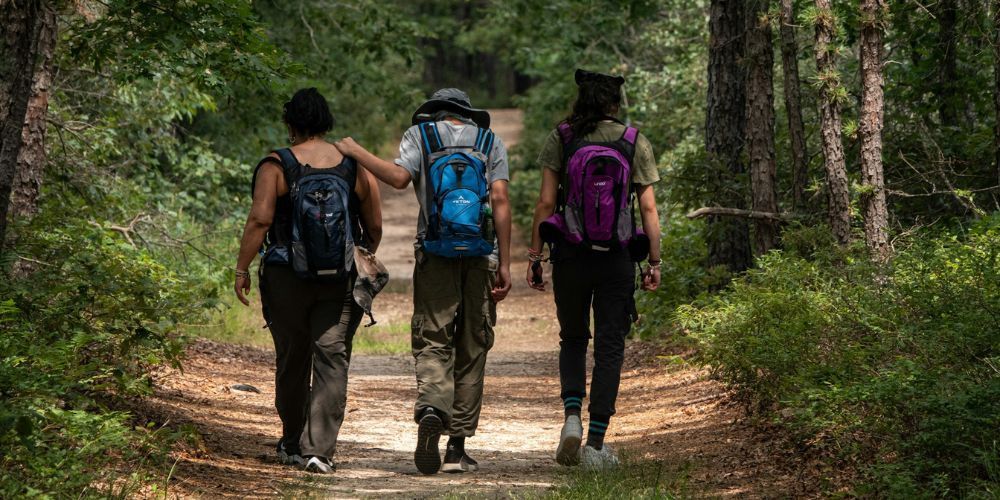
Staying Connected and Using Technology
When heading into the wilderness, it's crucial to stay as connected as possible, especially in areas with limited cell reception. The rise of technology has provided us with various tools and devices that can significantly enhance our safety and overall experience on the trail.
Mobile Apps for Safety
One of the most powerful tools for hikers is a smartphone equipped with the right apps. For instance, what3words is a location-sharing app that divides the world into 3m x 3m squares and assigns each one a unique combination of three words. This makes it easier for rescue teams to pinpoint your exact location in emergencies, even in areas without traditional addresses or landmarks. In urgent situations, when every minute counts, these types of apps can be true lifesavers. Additionally, OuterSpatial provides detailed maps and comprehensive trail information to aid hikers in navigating unfamiliar terrain while providing crucial insights into local flora, fauna, and potential hazards.
Emergency Devices
In areas with poor cell reception or during long treks through remote regions, it's prudent to carry a Personal Locator Beacon (PLB) or a satellite messenger. A PLB is an essential emergency device that, when activated, transmits a distress signal along with your GPS coordinates to emergency responders via satellite. On the other hand, satellite messengers not only allow you to send SOS messages but also feature two-way communication capability, enabling direct communication with search and rescue personnel.
In the vast expanse of wilderness, these devices serve as crucial lifelines, ensuring that help is just a button press away. They provide peace of mind, knowing that even in the most isolated areas, emergency assistance can be summoned swiftly. It’s important to familiarize yourself with the operation of these devices before setting out.
Battery Management
Given the reliance on technology while hiking, effectively managing your battery life becomes paramount. To ensure uninterrupted access to your devices like phones and GPS systems, always start your trek with fully charged batteries. It's also wise to bring along portable chargers or battery packs to keep your devices powered throughout your hike.
Meticulous management of your power supply is crucial, as these devices are indispensable for navigation, communication, and summoning help when needed. It's better to be over-prepared than risk being caught in an emergency with drained batteries.
By staying connected through technology and utilizing an array of available apps and devices designed for outdoor enthusiasts, hikers can drastically elevate their safety levels while out in nature—embracing the joys of trekking while feeling secure in their ability to handle unexpected challenges.
Equipped with these technological advancements and safety measures, hikers can tread with confidence through diverse terrains, knowing that they have reliable means of seeking assistance in case of unforeseen circumstances.
What should I do if I encounter wildlife while hiking?
Encountering wildlife can be a thrilling yet intimidating experience. It’s crucial to handle these situations with care to ensure your safety and that of the animals. Here are some guidelines for different types of wildlife:
- Bears: If you see a bear from a distance, do not approach it. Make your presence known by talking loudly or clapping your hands. If the bear sees you and doesn’t leave, back away slowly without turning your back on the bear. If a bear approaches, stand your ground, make yourself look larger by raising your arms, and make noise. Never run, as this can trigger a chase response. If the bear charges, it may be a bluff charge; stand your ground and be prepared to use bear spray if you have it.
- Snakes: Most snakes are not aggressive and will avoid human contact. If you see a snake, give it plenty of space and do not attempt to touch or move it. Watch where you step, especially in tall grass or rocky areas. If bitten by a venomous snake, seek medical help immediately and try to keep the affected limb immobilized and at or below heart level.
- Mountain Lions: If you encounter a mountain lion, make yourself look larger by raising your arms and speaking firmly. Do not run; instead, back away slowly while maintaining eye contact. If the mountain lion behaves aggressively, throw stones, branches, or whatever you can find without crouching down or turning your back. Fight back if attacked, targeting the animal’s eyes and face.
- Smaller Animals (Deer, Raccoons, etc.): Keep a safe distance and do not attempt to feed or touch any wild animals. These animals can carry diseases and may behave unpredictably if they feel threatened.
How can I stay safe if I get lost while hiking?
Getting lost while hiking can be a frightening experience, but staying calm and following these steps can help you find your way back safely:
- Stay Calm and Stay Put: If you realize you’re lost, the best action is to stay where you are. This makes it easier for rescuers to find you. Take deep breaths to stay calm and think clearly.
- Assess Your Situation: Check your map, compass, and GPS if you have them. Try to determine your last known location and see if you can identify any landmarks. Use your whistle or call for help at regular intervals to alert nearby hikers or rescuers.
- Create a Safe Shelter: If it looks like you’ll be spending the night outdoors, find or create a shelter to protect yourself from the elements. Use available materials like branches, leaves, or a poncho to make a temporary shelter.
- Signal for Help: Use bright clothing, a mirror, or a flashlight to signal rescuers. Create large symbols on the ground, such as an SOS or an X, using rocks, sticks, or other materials that can be seen from the air.
- Ration Food and Water: If you have supplies, ration them carefully. Drink water regularly to stay hydrated and eat small amounts of food to maintain your energy levels.
What are the essential items to carry for trail safety?
Carrying the right gear can significantly enhance your safety while hiking in the wilderness. Here are some essential items you should always bring:
- Navigation Tools: A map, compass, and GPS device or smartphone with offline maps are crucial for finding your way and avoiding getting lost. Familiarize yourself with how to use these tools before heading out.
- First Aid Kit: A well-stocked first aid kit can help you treat minor injuries and manage more serious ones until help arrives. Include items like bandages, antiseptic wipes, blister treatment, tweezers, and any personal medications.
- Hydration and Food: Bring enough water to stay hydrated and a way to purify additional water if needed. Carry high-energy snacks like trail mix, energy bars, and dried fruit to keep your energy levels up.
- Weather-Appropriate Clothing: Wear layers to adjust to changing weather conditions. Pack a waterproof jacket, hat, gloves, and an extra pair of socks. Avoid cotton clothing, as it retains moisture and can lead to hypothermia.
- Shelter and Fire: Even on day hikes, it’s wise to carry a lightweight emergency shelter like a space blanket or bivy sack. Bring fire-starting materials, such as waterproof matches, a lighter, and fire starters, to stay warm and signal for help.
- Multi-Tool or Knife: A multi-tool or knife can be useful for various tasks, from preparing food to making repairs or building a shelter.
- Lighting: A headlamp or flashlight with extra batteries is essential for navigating in the dark or during emergencies.
- Whistle and Signaling Devices: A whistle can be heard from a distance and is a reliable way to signal for help. Other signaling devices like a mirror or brightly colored cloth can also be useful.
By carrying these essential items and knowing how to use them, you can enhance your safety and preparedness while hiking in the wilderness.


